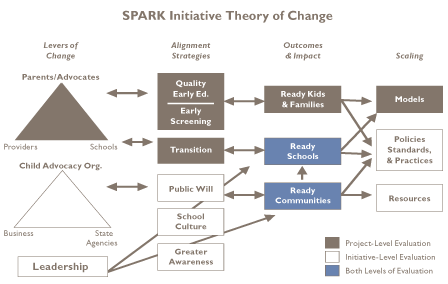The Harvard Family Research Project separated from the Harvard Graduate School of Education to become the Global Family Research Project as of January 1, 2017. It is no longer affiliated with Harvard University.
Volume XI, Number 1, Spring 2005
Issue Topic: Complementary Learning
Spotlight
SPARKing Innovation
Tony Berkley of the W. K. Kellogg Foundation describes the application of a theory of change to a complex initiative to facilitate team learning, strategic management, and program improvement.
Supporting Partnerships to Assure Ready Kids (SPARK) is a national initiative involving partnerships of communities, state agencies, and schools in seven states¹ and the District of Columbia. These partners coordinate comprehensive support for quality early learning experiences for children ages 3–6 who are vulnerable to poor achievement. SPARK also helps communities unite resources to better prepare young children for school and to better prepare elementary schools for children.
SPARK grantees work toward three readiness outcomes: (a) improved early care and education, better screenings, and the cultivation of parents and others as learning advocates for children; (b) improved transition and alignment between preschool, kindergarten, and first grade; and (c) mobilization of public will to put children at the center of a seamless continuum for early and elementary education.
The SPARK Theory of Change
A theory of change (TOC) is a plain-language explanation for why programming should work in the real world. More dynamic and more focused than traditional logic models,² it is a collective process of interpretation and planning through which variables essential for strategic management are made visible and actionable. These variables include leverage points for systems change, factors critical for success, and pathways to scalability and sustainability. The theory of change is well-suited to long-term, complex initiatives in which design and implementation evolve.
SPARK's theory of change can be described in this way: Effective partnerships and leadership work to align community systems and increase the readiness of children, schools, and communities. The levers of change are therefore partnerships—two distinct collaborations of partners within each SPARK site/state—and an intentional leadership development effort involving key partners who become agents of local, state, and national change.
The theory of change answers basic who, what, where, when, and how questions. As the figure below illustrates, Levers of Change tell us that two broad-based coalitions, as well as key leaders, drive alignment strategies at the local community and school levels, and at the larger state level. The arrows leading to and from Alignment Strategies tell us that partnerships and leaders are working in concert through distinct strategies to achieve agreed-upon outcomes. Under Outcomes and Impact, we see what those outcomes are, who is responsible for them, and how they will be achieved. Finally, Scaling reminds us that SPARK is for everyone, not just the 8,000 kids being served. Reading the figure from left to right narrates the pathways through which SPARK will achieve local, state, and national impact.
For evaluators, the theory of change is neither a set of commandments nor a standard for measurement. As the initiative unfolds, the TOC helps connect the pieces and integrate far-flung participants into a learning community. This community manifests itself in a variety of communication opportunities, including monthly management calls with site directors and foundation staff, annual networking conferences, and a website, www.sparkkids.org.
The SPARK theory of change also is an effective tool for coordinating a two-tiered evaluation effort. The figure's shading helps communicate who is responsible for collecting what and identifies critical points of coordination between evaluators.
One of the most important benefits of Spark's theory of change is that it provides a framework and common language through which evaluation results can be communicated; for example, annual evaluation reports are guided by questions derived from the theory of change. Undoubtedly, we will learn much about the value of a theory of change over the next 5 years. At the moment it is clear that this new way of working unleashes a spirit of enquiry and boldness, and acknowledges a commitment to continuous learning.

¹ The seven states are North Carolina, Florida, Georgia, Ohio, Mississippi, New Mexico, and Hawaii.
² A logic model illustrates how an initiative's activities connect to the outcomes it is trying to achieve.
Tony Berkley
Evaluation Manager
Youth & Education
W. K. Kellogg Foundation
One Michigan Avenue
Battle Creek, MI 49017-4058
Email: tberkley@wkkf.org

